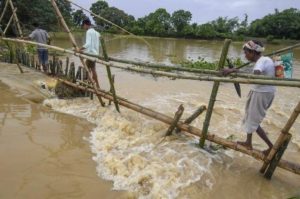
Heavy rain that led to unprecedented floods has hit the beleaguered tea industry of Assam hard.
Barak Valley alone received 74.73 cm of rainfall in May and 89.43 cm in June, leading to unprecedented devastation, while South Assam’s most important city Silchar was 90% under water.
In Upper Assam, which has the maximum tea-producing districts, the rain in May was 42.79 cm, while June saw a drop in rain.
In North Bengal, the tea-producing Dooars and Terrai received 41.85 cm of rain in May, and 121.55 cm in June.
On an average, the rain was almost double the amount that Assam and North Bengal received in 2021.
THE SLUMP
The tea industry in NorthEast India, comprising Assam and North Bengal, produces almost 81% of the country’s total production.
Excessive rain and floods have directly impacted the harvest, pushing the tea industry into a slump. In June, Assam and Cachar faced 11% and 16% drop, respectively, while Dooars and Terai faced 21% and 19% drop, respectively, against the harvest in the corresponding period the previous year.
“The drop in the production is because of lowering of the average maximum temperature by 1.5°C in June, resulting in lower average sunshine hours to the extent that some of the regions witnessed no sunshine in 11 days in June. This widened the diurnal temperature variations compared to last June. The industry has recently been impacted by a rise in wages of Rs 30 per day in North Bengal and a rise in wages in Assam cannot be ruled out,” said P K Bhattacharjee, General Secretary, Tea Association of India.
Moreover, the prices of CTC Tea in May in the regions of Brahmaputra Valley, Barak Valley, Dooars and Terai fell around 15%.
“The viability of the tea Industry continues to be impacted by the twin factors of market forces and regression arising out of extreme climate,” added the General Secretary.
TEMPERATURE CONTROL
Temperature is one of the main factors affecting the growth of tea and determines the time that will be taken to harvest tea buds in a one-year cycle.
Tea requires cool to warm temperatures with at least five hours of sunlight per day. The average annual temperature for tea plants to grow well is in the range of 15-23°C. Tea plants require a total annual temperature of 3,500-4,000°C.
Temperatures that are too high or too low both affect the accumulation of tannins in tea. When the temperature is higher than 35°C, the process of accumulation of tannin is inhibited. If the temperature exceeds 35°C continuously for a long time, it leads to burning of tea leaves.
In contrast, when the temperature is low, it changes the physiological and chemical composition of the tea buds. This adversely affects the growth of the plant and the quality of the buds.
Green tea grown at high temperatures has lower levels of caffeine and catechins than those grown at lower temperatures.
Rainfall and rainfall distribution have an influence on the growing period and length of the tea harvest season.
The average total rainfall in a year needed for tea is about 1,500 mm and the rain is evenly distributed over months. The minimum annual rainfall is 1,000 mm, and monthly 50 mm. The average rain during the tea-growing period must be greater than or equal to 100 mm. If less than 100 mm, the tea will not grow well.




 Driving Naari Programme launched in Chandigarh
Driving Naari Programme launched in Chandigarh






























